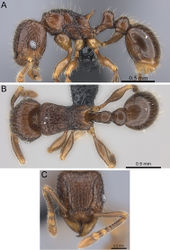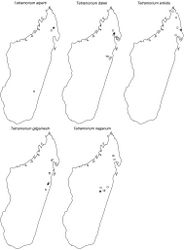Tetramorium alperti
| Notice: | This page is derived from the original publication listed below, whose author(s) should always be credited. Further contributors may edit and improve the content of this page and, consequently, need to be credited as well (see page history). Any assessment of factual correctness requires a careful review of the original article as well as of subsequent contributions.
If you are uncertain whether your planned contribution is correct or not, we suggest that you use the associated discussion page instead of editing the page directly. This page should be cited as follows (rationale):
Citation formats to copy and paste
BibTeX: @article{Hita2014ZooKeys413, RIS/ Endnote: TY - JOUR Wikipedia/ Citizendium: <ref name="Hita2014ZooKeys413">{{Citation See also the citation download page at the journal. |
Ordo: Hymenoptera
Familia: Formicidae
Genus: Tetramorium
Name
Tetramorium alperti Hita Garcia & Fisher sp. n. – Wikispecies link – ZooBank link – Pensoft Profile
Type material
Holotype, pinned worker, MADAGASCAR, Antsiranana, Parc National de Marojejy, Antranohofa, 26.6 km 31° NNE Andapa, 10.7 km 318° NW Manantenina, 14.44333°S, 49.74333°E, 1325 m, montane rainforest, sifted litter (leaf mould, rotten wood), collection code BLF09080, 18.XI.2003 (B.L. Fisher) (CAS: CASENT0042547). Paratypes, nine pinned workers with same data as holotype (BMNH: CASENT0042817; CAS: CASENT0042703; CASENT0042704; CASENT0042708; CASENT0042813; CASENT0042815; CASENT0042827; CASENT0042835; MCZ: CASENT0042821).
Non-type material
MADAGASCAR: Antsiranana, Rés. Anjanaharibe-Sud, 9.2 km WSW Befingotra, 14.75°S, 49.46667°E, 1280 m, montane rainforest, 5.XI.1994 (B.L. Fisher); Fianarantsoa, Foret d’Ambalagoavy Nord, Ikongo, Ambatombe, 21.8275°S, 47.33889°E, 625 m, 1.XII.2000 (R. Harin’Hala & M.E. Irwin).
Diagnosis
Tetramorium alperti differs from the other three species of the group by the following character combination: propodeal spines long to very long (PSLI 29–37); waist segments with several long erect hairs; first gastral tergite with moderately long, scattered, appressed to decumbent pubescence in combination with several much longer, erect standing hairs.
Worker measurements
(N=10). HL 0.56–0.68 (0.64); HW 0.54–0.65 (0.62); SL 0.40–0.47 (0.45); EL 0.13–0.15 (0.14); PH 0.31–0.38 (0.35); PW 0.40–0.50 (0.47); WL 0.70–0.84 (0.79); PSL 0.18–0.23 (0.21); PTL 0.15–0.18 (0.16); PTH 0.23–0.28 (0.26); PTW 0.16–0.19 (0.18); PPL 0.17–0.22 (0.20); PPH 0.23–0.27 (0.25); PPW 0.22–0.28 (0.26); CI 95–97 (96); SI 69–75 (73); OI 22–23 (23); DMI 57–62 (59); LMI 42–46 (44); PSLI 29–37 (33); PeNI 36–40 (38); LPeI 62–68 (64); DPeI 103–115 (108); PpNI 54–57 (55); LPpI 74–84 (80); DPpI 126–132 (128); PPI 139–156 (145).
Worker description
Head longer than wide (CI 95–97); posterior head margin weakly concave. Anterior clypeal margin with distinct median impression. Frontal carinae strongly developed, diverging posteriorly and approaching or ending at posterior head margin; antennal scrobe present, but weak, shallow, and without defined posterior or ventral margins. Antennal scapes short, not reaching posterior head margin (SI 69–75). Eyes of moderate size (OI 22–23). Mesosomal outline in profile flat to weakly convex, relatively high (LMI 42–46), and moderately to strongly marginate from lateral to dorsal mesosoma; promesonotal suture and metanotal groove absent. Propodeal spines long to very long, spinose, acute, and often thick (PSLI 29–37); propodeal lobes short, triangular, and blunt or acute, always much shorter than propodeal spines. Petiolar node in profile high, rounded nodiform with moderately rounded antero- and posterodorsal margins, around 1.5 to 1.6 times higher than long (LPeI 62–68), anterior and posterior faces approximately parallel, anterodorsal and posterodorsal margins situated at about the same height and equally marginate, petiolar dorsum weakly convex; node in dorsal view around 1.0 to 1.1 times wider than long (DPeI 103–115), in dorsal view pronotum between 2.4 to 2.8 times wider than petiolar node (PeNI 36–40). Postpetiole in profile globular to subglobular, approximately 1.2 to 1.3 times higher than long (LPpI 74–84); in dorsal view around 1.2 to 1.3 times wider than long (DPpI 126–132), pronotum between 1.7 to 1.8 times wider than postpetiole (PpNI 54–57). Postpetiole in profile appearing less voluminous than petiolar node, postpetiole in dorsal view between 1.3 to 1.6 times wider than petiolar node (PPI 139–156). Mandibles usually mostly unsculptured and smooth with some weakly striate parts, generally very shiny; clypeus longitudinally rugose/rugulose, with three to five rugae/rugulae, median ruga always well developed and distinct, lateral rugae/rugulae sometimes weaker and interrupted; cephalic dorsum between frontal carinae with seven to nine longitudinal rugae, rugae running from posterior clypeal margin to posterior head margin, often interrupted or with cross-meshes, especially posteriorly; scrobal area mostly unsculptured; lateral head reticulate-rugose to longitudinally rugose. Ground sculpture on head absent to weakly punctate. Dorsum of mesosoma mostly irregularly longitudinally rugose; lateral mesosoma variably sculptured, lateral pronotum and anepisternum mostly unsculptured, smooth and shining with very little sculpture, usually only traces of rugulae present, katepisternum, metapleuron, and lateral propodeum noticeably irregularly longitudinally rugose. Forecoxae unsculptured, smooth and shining. Ground sculpture on mesosoma weak to absent. Waist segments and gaster completely unsculptured, smooth and shining. Whole body with numerous, long, and fine standing hairs; first gastral tergite with moderately long, relatively scattered, appressed to decumbent pubescence in combination with several much longer, fine, and erect hairs. Anterior edges of antennal scapes and dorsal (outer) surfaces of hind tibiae usually with decumbent to suberect hairs. Head, mesosoma, waist segments, and gaster orange-brown to chestnut brown, mandibles, antennae, and legs always lighter, usually yellowish brown.
Etymology
The name of the new species is a patronym dedicated to Gary D. Alpert from Cambridge, Massachusetts, U.S.A., to honour his numerous ant collecting activities in Madagascar.
Distribution and biology
This new species is only known from three localities (Fig. 61). Two are located in the northeast of Madagascar (Anjanaharibe-Sud and Marorejy) while the third is found much further south (Ambalagoavy). Anjanaharibe-Sud and Marorejy are montane forests ranging from 1280 to 1325 m elevation, whereas Ambalagoavy is located at 525 m. This distributional and elevational pattern suggests that Tetramorium alperti might have been distributed throughout most of the eastern Madagascar humid forests, but is now only found in a few montane forests and one lower rainforest site. Based on the available collection data, Tetramorium alperti seems to be a leaf litter inhabitant.
Discussion
Tetramorium alperti cannot be confused with Tetramorium dalek since the latter has no long standing hairs on the waist segments and the first gastral tergite, while these are present in Tetramorium alperti. Differentiation from the other three species of the group, however, is more challenging. The primary diagnostic characters distinguishing Tetramorium alperti are the pilosity/pubescence pattern on the first gastral tergite and the shape of the petiolar node in profile. Tetramorium alperti possesses moderately long, relatively scattered, appressed to decumbent pubescence in combination with several much longer and erect hairs. This pattern on the first gastral tergite is not found in Tetramorium enkidu, Tetramorium gilgamesh or Tetramorium naganum since they either lack long and erect hairs or appressed to decumbent pubescence entirely. In addition, Tetramorium alperti also has a thicker petiolar node which is around 1.5 to 1.6 times higher than long (LPeI 62–68), compared to Tetramorium gilgamesh and Tetramorium naganum, in which the petiolar nodes are around 1.7 to 2.0 times higher than long (LPeI 50–59). The species probably most easily confused with Tetramorium alperti is Tetramorium enkidu since both share the same general habitus and the same morphometric range, and the only difference is the pattern of pilosity/pubescence on the first gastral tergite outlined above. Possibly they are conspecific and the differences in gastral pilosity/pubescence represent intraspecific variation, however, there are some good arguments to separate them as two distinct species. First, both species are found in sympatry in Marojejy, and they are easily identified by the differences in pilosity/pubescence mentioned above without any intermediate forms. Second, patterns of pilosity/pubescence are usually very species-specific within the genus Tetramorium (e.g. Bolton 1976[1], 1980[2]; Hita Garcia et al. 2010[3]; Hita Garcia and Fisher 2012a[4], 2012b[5]). We were able to reveal several consistent patterns of pilosity/pubescence in the Tetramorium naganum species group, and the pattern of Tetramorium alperti is unique to this group, although it resembles the one seen in Tetramorium ryanphelanae Hita Garcia & Fisher from the Tetramorium bessonii species group, and a few species from the Tetramorium schaufussii species complex.
To our knowledge, there is no significant intraspecific variation in the material treated as Tetramorium alperti.
Original Description
- Hita Garcia, F; Fisher, B; 2014: The hyper-diverse ant genus Tetramorium Mayr (Hymenoptera, Formicidae) in the Malagasy region taxonomic revision of the T. naganum, T. plesiarum, T. schaufussii, and T. severini species groups ZooKeys, 413: 1-170. doi
Images
|
Other References
- ↑ Bolton B (1976) The ant tribe Tetramoriini (Hymenoptera: Formicidae). Constituent genera, review of smaller genera and revision of Triglyphothrix Forel. Bulletin of the British Museum (Natural History) Entomology 34: 281–379.
- ↑ Bolton B (1980) The ant tribe Tetramoriini (Hymenoptera: Formicidae). The genus Tetramorium Mayr in the Ethiopian zoogeographical region. Bulletin of the British Museum (Natural History) Entomology 40: 193–384.
- ↑ Hita Garcia F, Fischer G, Peters M (2010) Taxonomy of the Tetramorium weitzeckeri species group (Hymenoptera: Formicidae) in the Afrotropical zoogeographical region. Zootaxa 2704: 1–90.
- ↑ Hita Garcia F, Fisher B (2012a) The ant genus Tetramorium Mayr (Hymenoptera: Formicidae) in the Malagasy region—taxonomic revision of the T. kelleri and T. tortuosum species groups. Zootaxa 3592: 1–85.
- ↑ Hita Garcia F, Fisher B (2012b) The ant genus Tetramorium Mayr (Hymenoptera: Formicidae) in the Malagasy region—taxonomy of the T. bessonii, T. bonibony, T. dysalum, T. marginatum, T. tsingy, and T. weitzeckeri species groups. Zootaxa 3365: 1–123.



